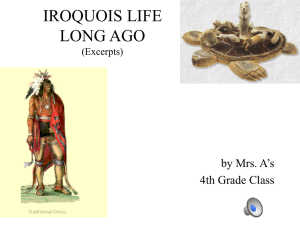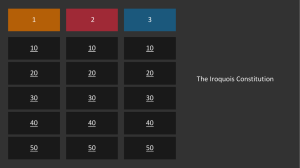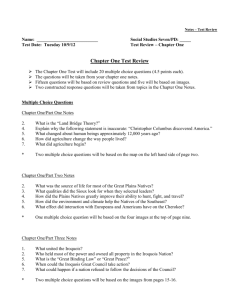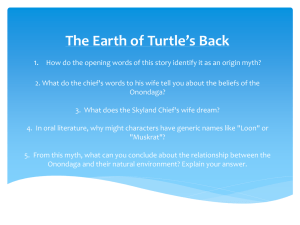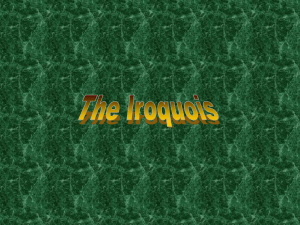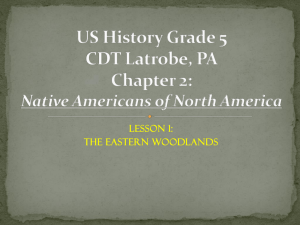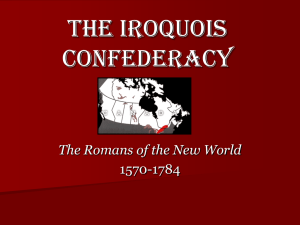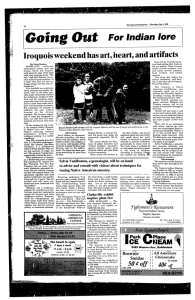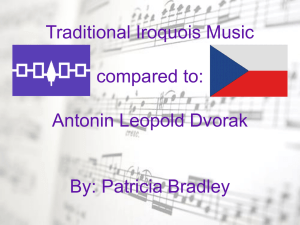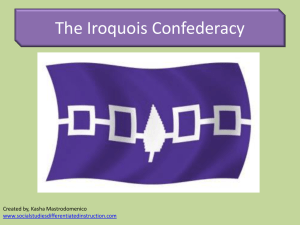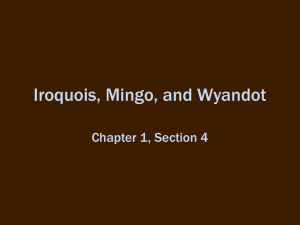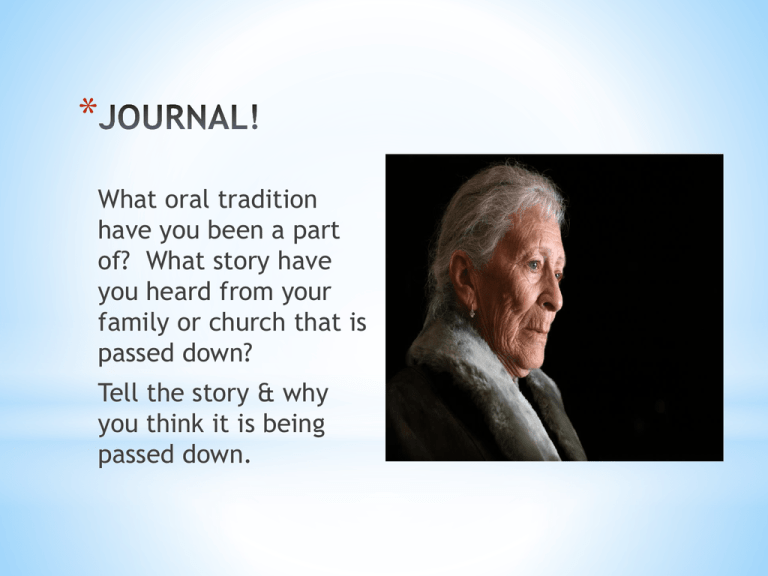
*
What oral tradition
have you been a part
of? What story have
you heard from your
family or church that is
passed down?
Tell the story & why
you think it is being
passed down.
* TEXTBOOK??
* Journal
* Voc. Ppt. & Homework
* Native-American Story-Telling
* 2 Video Clips
* Gallery Walk
* Essay revision
*
*
EQ: How does oral tradition impact us
today?
* Many religious writings, including the Bible, were
originally passed down through oral tradition until written.
* Greek & Roman myths
* Homer’s Iliad and Odyssey
* African tales
* Viking & Germanic stories (like Beowulf)
* Native-American stories & legends
* African-American stories & songs:
video "Language & Oral Tradition"
*
* Native American Story-Telling
* Take notes on the handout.
*
*
Teach lessons
Explain the world around them
*
Silently read pp. 15-16.
Why are storytellers important to this modern
Native American writer?
* Circulate from one station to another with your
group.
* Do the activity in the folder.
ONE person
writes for the group.
* Leave the paper in the folder.
other people’s papers yet!
* Last station is different.
*
Do NOT look at
* EVALUATE the answers in the folder I give your
group. Which is best? Pick someone to read
the answers.
*
*
Get out your books/magazines now to read SILENTLY.
You will have an activity afterwards on your reading.
* Pick out a sentence or two
*
from your reading that was
interesting, profound, or
irritating! THINK.
* Write it in your journal and put
quotation marks around it &
parentheses after it. (Author’s
last name page no.) INK.
* Below it explain the passage,
argue with it, tell a story that
happened that it reminds you
of. LINK.
* YOU MUST FILL UP THE
PAGE!!!!!!!!!!!!!!
* Switch snippets/journals. On
the back write a letter to
him/her. React to what was
written. You can draw as well
as write, but you must FILL UP
THE BACK!
* AIR Time & Snippet
* Voc. In Pairs (Homework)
* Native-American Story-Telling Review
* Gallery Walk Follow-Up
* Questions on Legends
*
*
*
EQ: How does oral tradition impact us
today?
*
Read pp. 15-16.
Why are storytellers important to this modern
Native American writer?
* 2nd period. . . Look up on the board.
Read the
3 passages in our text & do questions on P. 23 &
28 in whole sentences to turn in.
* 3rd period . . .
Read the one passage you have
not yet read & do questions on P. 23 & 28 in
whole sentences to turn in. THEN work WITH A
PARTNER on questions 1-4, 7, & 9 (P. 29).
*
* Patterns, symbols, or characters that repeat
across cultures
* Native American ones:
coyote, turtle, wind,
compass points
*
*
What difficulties would he/she have
in understanding our society today?
Would he/she judge us? Why/not?
*
You have 10-15 min.
*
*
EQ: How does an archetype function in
entertainment or didactic literature today?
*
NOTES:
1.
2.
Modoc “When Grizzlies Walked Upright” (pp. 24-26)
– dark, grim
Navajo from the Navajo Origin Legend (pp. 27-28)
* Patterns, symbols, or characters that repeat
across cultures
* Native American ones:
coyote, turtle, wind,
compass points, grizzly bears
* Can be in entertainment or didactic (teaching)
literature
*
*
pp. 20-23
Re-read and do questions (5) on P. 23.
*Fill out the matrix on the
3 pieces we have read.
*Select a Native-American
*
tribe or any ethnicity you
would like to research.
*Find online an origin myth
of that people.
*Read it and fill in the 4th
column of the matrix.
Make SURE to name the
people.
* Option 1:
Describe your visit to a museum.
What did you see? Did you want to be there?
What object stood out to you and why?
* Option 2:
If you time-traveled to a museum
100 years in the future, what would be there?
Why? Describe the displays.
*
* Journal
* Review of Origin Myths
* Horton Hears a Who & ppt. w/ movie trailer
* “Museum Indians”
* Practice Quiz or Vocab Icons
*
*
EQ: How does heritage impact us today?
How can it alienate us in modern society?
*
*
Write notes as we discuss whole-class.
*What is an archetype in
modern movies?
*
* Motif = recurring topic or image (like an archetype)
* Alienation = separation and isolation
* Disenfranchisement = the state of having no
ownership or voice
*
*
How does this book illustrate
disenfranchisement & alienation?
*
Horton
Who’s
Whoville
* What is the implication of
items in a museum?
*Night at the Museum 3
*
What is the author’s tone towards her heritage?
What has disenfranchised her? How?
Do questions on P. 39 when done reading.
* What is another
disenfranchised group
today?
* What is causing their
*
alienation?
Write your idea on a sticky
note and slap it on the left
board before leaving.
*What is another
disenfranchised
group today?
*What is causing
their alienation?
*
*
*
*
Read afterwards.
*
EQ: How does Native-American heritage
impact our government today?
Whip-Around
Stand & tell one fact you remember from reading, watching, discussing, researching
Native-American legends/myths/modern memoir. You can PASS once only!
*
Forerunner of the Constitution
of the U.S.A.
pp. 41-43
Decide if the title to this
video is accurate, biased,
exaggerated, understated,
&/or merely inflammatory.
Be able to defend with
evidence from the video.
* Iroquois united in 16th century or earlier.
* Dekanawidah, prophet, urged bands in N. Y. to
quit fighting and unite.
* Five Nations (confederacy of Seneca, Cayuga,
Onondaga, Oneida, & Mohawk tribes) = Iroquois
* Later Tuscarora joined the Six Nations.
* Gained power over other tribes later
* Helped the British win the French & Indian War
* Divided during the Revolutionary War
*
* United the Iroquois
* Established laws & practices
* Passed down orally for generations
* Recorded in shell beads called wampum
(memory device for oral tradition)
* Now called the Iroquois Constitution
* Written down in 1800s
*
* An Onondaga named Canassatego suggested that the
colonists form a nation similar to the Iroquois
Confederacy during a meeting of the Provincial
Council of Pennsylvania in Lancaster on June 25,
1744.
* According to the director of the Historical Society
of Pennsylvania, Peter J. Parker, the council
minutes show that Canassatego urged the colonists
to ''receive these your brethren with open arms;
unite yourselves to them in the covenant chain and
be you with them as one body and one soul.'‘
* ''They contemplated examples from Europe,
examples from Greco-Roman times, examples from
the Bible,'' he said. ''And they also looked at Native
American examples, particularly the Iroquois
Confederacy.''
*
* One forum to share ideas between the colonists and
the Iroquois, in the years leading to the French and
Indian War, was the the Albany Congress between
June 19 and July 9, 1754. At the meeting,
representatives of the six Indian nations and seven
colonies heard Benjamin Franklin champion the
Iroquois example as he presented his Plan of Union.
* ''It would be a strange thing,'' he told the assembly,
''if six nations of ignorant savages should be capable
of forming such a union, and yet it has subsisted for
ages and appears indissolvable, and yet a like union
should be impractical for 10 or a dozen English
colonies.''
*
*
*
How could this be important in
oral tradition?
* The Iroquois’ tree’s roots
were strength and peace.
* Draw a Tree of Great Peace
for America today. Include its
roots & name them. What are
the roots (origins) of peace
for us? Why?
* Name 3-5 of the leaves
(results).
*
*Go to my webpage &
under Helpful Links,
read Eng. III Iroquois
Constitution article.
*Venn diagram the
similarities/diff.
between the U.S.
Constitution & the
Iroquois’ one.
*
* Why do you think
Dekanawidah was successful?
*

